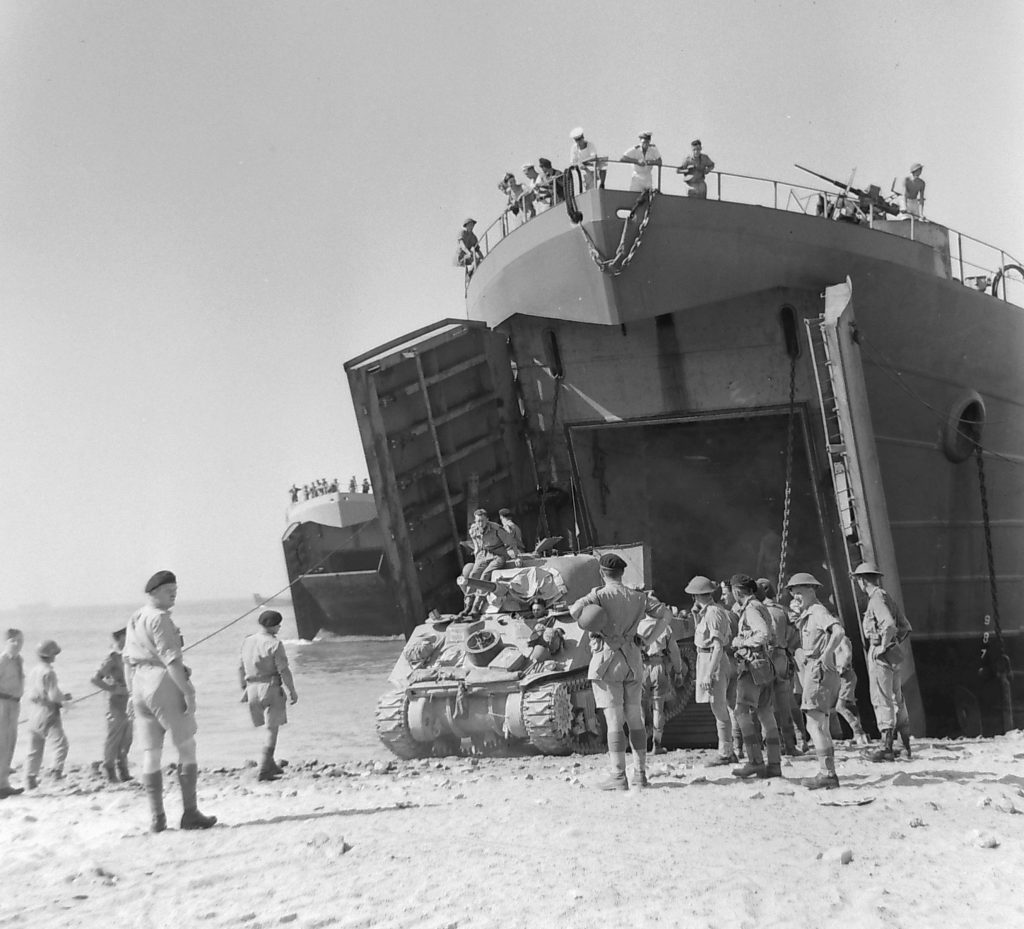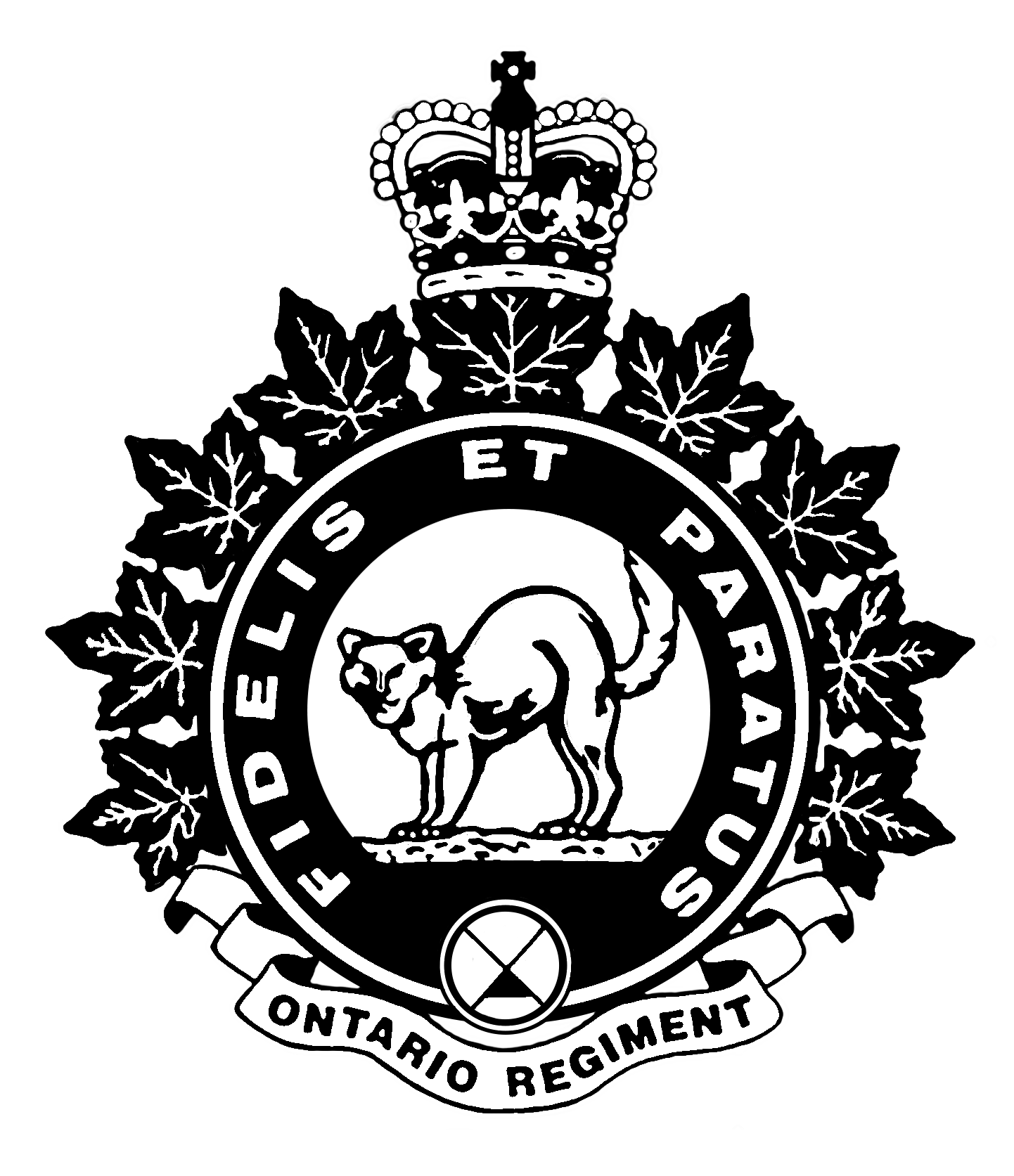In the previous article the Sicilian Campaign had wrapped up and the Ontarios were preparing for the next campaign – the invasion of mainland Italy, code named Operation “Baytown”.
The Ontario Regiment was tasked with supporting the British 5th Infantry Division on the Calabrian coast. Multiple simultaneous Allied landings led to a shortage of landing craft, forcing the 5th Infantry Division to use a ferry system to transfer all of its vehicles to the Italian mainland. “B” Squadron of the Ontario Regiment was assigned to support the British 17th Brigade during the initial landings.

The Ontario Regiment’s landing area is highlighted in yellow. The blue line shows the Regiment’s movements in the first 5 days after landing in Italy.
The tanks and other vehicles of “B” Squadron and Regimental Headquarters were loaded on Landing Ships, Tank (LST) at Catania, Sicily on 30 August. They sailed south to Augusta harbour until the invasion time. The task force left Augusta at 01:00 hours of 3 September, crossed the Strait of Messina to the Italian mainland, and landed at a beach near Gallico at 09:00 hours of 3 September.

Ontario Regiment tanks unload from a Landing Ship, Tank at Gallico. Library and Archives Canada / PA-183309
The landing of “B” Squadron was largely unopposed, except for a few raids by fighter-bombers and light shelling, as most of the German forces had withdrawn to the north. A few Italian soldiers of the coastal defence force appeared on the beach, happily waving white flags and offering to surrender. “B” squadron moved up the main road to a harbour area north of Catona and waited for orders. Regimental Headquarters landed at 11:00 hours. “A” Squadron’s wheeled vehicles arrived on the mainland on 4 September and its tanks landed on the 5th . The squadron also moved into a harbour area north of Catona. “C” Squadron remained in Sicily for the time being.

Ontario Regiment tanks unload from a Landing Ship, Tank at Gallico. Library and Archives Canada / PA-183308
The Italians announced their surrender on 8 September, although this meant very little to the campaign. On the same day the Regiment was on the move. The Germans were not putting up much of a fight and the Ontarios were ordered north. There were more road moves over the next two weeks for the Ontarios, each time moving to new harbour areas progressively farther north along the west coast of Italy, following behind the British infantry.
Four Landing Craft, Tank (smaller than an LST) were placed under command of the Ontario Regiment. These were used to ferry “C” Squadron from Sicily. “C” Squadron arrived on the mainland over the course of 18-19 September and harboured with the remainder of the Regiment near the coastal town of Praia a Mare. After fifteen days on the mainland the Calabrian campaign was over, with the Ontarios moving about 250 kilometers along narrow, winding coastal roads. Not a shot had been fired by the Regiment.
By 27 September the Allied advance on the east coast was moving quickly and the services of the Ontarios were required there. The wheeled vehicles drove north to the Foggia area, while the tanks were loaded on LSTs and LCTs for the journey. Bad weather at sea slowed the vessels, but the first ships arrived in Manfredonia on 7 October, with the remainder trickling in until the 11th .

Ontario Regiment tanks are moved via Diamond-T tank transporters on 12 October 1943. Library and Archives Canada / PA-142076
Lieutenant-Colonel Johnston suffered a knee injury in a jeep accident on 1 October. The injury and the resulting fever required him to be medically evacuated. Major Herbert R. Schell assumed command of the Regiment on an acting basis. In mid-month he was named as the new CO and before the end of the month he was promoted to lieutenant colonel. Major R.B. Kerr was appointed deputy commanding officer and Major Harry Millen became “A” Squadron commander. LCol Schell was a prewar member of the Regiment, having joined the Ontarios as a second lieutenant in 1932. At the outset of the war he was a lieutenant and rose through the officer ranks. In civilian life Schell was an executive officer with the Schofield Woolen Company Ltd.
By mid-October the Regiment’s squadrons were each assigned to Canadian infantry brigades in the area south and south-east of Campobasso. The first few weeks of the Italian Campaign had been somewhat quiet and the Allied armies had made considerable progress advancing up the Italian peninsula. The Germans were about to stop retreating and the real fighting was to begin.
Rod Henderson
Rod Henderson is the Regimental Historian of the Ontario Regiment. He served as a Sergeant in the Regiment and is the author of “Fidelis Et Paratus: The History of The Ontario Regiment RCAC”.


